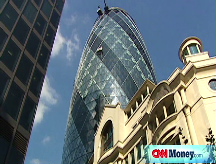Wall Street: Bring on '09
Investors close the books on the worst year since the Depression for the blue chips - and the worst year ever for the Nasdaq.

NEW YORK (CNNMoney.com) -- Stocks rallied Wednesday, as investors welcomed the end of an abysmal year on Wall Street and looked forward to a better year ahead.
All financial markets are closed Thursday for New Year's Day.
The Dow Jones industrial average (INDU) rose 1.3%. The Standard & Poor's 500 (SPX) index gained 1.4% and the Nasdaq composite (COMP) rose 1.7%.
For investors, 2008 has been the worst year since the 1930s. The Dow lost 33.8%, the S&P 500 38.5% and the Nasdaq 40.5%. (For details, click here).
Amid the housing market collapse, credit crunch, recession and consumer spending slowdown, stocks plunged. Oil prices tumbled 61%, reversing the upward trend of the previous few years, as the global economy slowed. Bond prices rallied, as investors sought the comparative safety of government debt, despite piddling returns on their money.
"If history is any guide, individuals will at some point realize that to see attractive returns, they need to get back into stocks," said John Wilson, chief technical strategist at Morgan Keegan
Wilson and other analysts are cautiously optimistic that Wall Street will recover some in 2009, despite continued stock volatility and the ongoing recession. (Full story)
"Looking out, there's a little optimism about next year that could push us higher through the inauguration," said Ryan Detrick, chief technical strategist at Schaeffer's Investment Research. "But beyond that, we are still going to be dealing with the same problems that got us here in the first place."
Wall Street surged Tuesday after the government said it will pour $6 billion into GMAC Financial Services, the financing arm of struggling automaker General Motors (GM, Fortune 500). On Wednesday, GMAC said it had raised $21.2 billion in a debt-for-capital swap in its continuing efforts to build up capital. Last week, the Federal Reserve granted GMAC's application to become a bank holding company.
Trading was light heading into the new year.
Market breadth was positive. On the New York Stock Exchange, winners topped losers by over five to one on volume of 1.31 billion shares. On the Nasdaq, advancers beat decliners three to one on volume of 1.61 billion shares.
Labor market: The number of Americans filing new claims for unemployment saw a surprisingly large drop last week, the biggest in 16 years, due largely to the Christmas holiday and other seasonal factors. The number of Americans continuing to receive unemployment benefits surged, however. (Full story)
Bonds: Treasury prices plunged, raising the corresponding yield on the benchmark 10-year note to 2.21% from 2.08% Monday. Treasury prices and yields move in opposite direction. Yields on the 2-year, 10-year and 30-year Treasurys all hit record lows last week.
Lending rates were mixed. The 3-month Libor rate slipped to a 4-1/2 year low of 1.42% Wednesday, down from 1.44% Tuesday, according to Bloomberg. Libor is a key bank lending rate.
Other markets: In global trading, Asian markets ended higher and European markets gained in afternoon trading.
The dollar fell against the euro and yen.
U.S. light crude oil for February delivery rose $1.82 to $40.85 a barrel on the New York Mercantile Exchange. Prices had been lower ahead of the release of the weekly oil inventories report, which showed a surprise rise in crude supplies and a smaller-than-expected rise in gasoline stockpiles.
COMEX gold for February delivery rose $14.30 to settle at $884.30 an ounce.
Gasoline prices rose 0.1 cent to a national average of $1.617 a gallon, according to a survey of credit-card swipes released Wednesday by motorist group AAA.
2008 market meltdown: The S&P declined nearly 38.5% - its worst yearly performance since an earlier version of the broad stock index lost 47% in 1931. That version had 90 U.S. stocks in it.
For the Nasdaq, this year's loss of 40.5% is the tech-fueled index's worst ever, going back to its inception in 1971.
All 10 of the economic sectors, as measured by Standard & Poor's, posted substantial losses this year. The worst performer was financials, which lost 58%. The so-called "best" performer was consumer staples, which lost 18%.
Only two of the 30 components that make up the Dow Jones industrial average ended the year higher. Wal-Mart Stores (WMT, Fortune 500) rose nearly 17%, while McDonald's (MCD, Fortune 500) rose over 5%. The Dow's biggest loser was GM, down 87% this year, followed by Citigroup (C, Fortune 500), which lost 77%.
On Wednesday, Citigroup said its top executives won't take bonuses, after the bank's incredibly difficult year.
Of the Nasdaq 100 companies, seven gained -- led by biotechs Vertex Pharmaceuticals (VRTX) and Amgen (AMGN, Fortune 500). The Nasdaq 100's biggest losers were Focus Media Holdings (FMCN) and Liberty Media Interactive (LINTA).
Of the S&P 500 stocks, 22 ended the year with gains. Consumer-staple companies led the group. Family Dollar Stores (FDO, Fortune 500) was the biggest gainer, rising 34%. The S&P 500's biggest loser was AIG (AIG, Fortune 500), which lost 96%. (Full story) ![]()







